Report on the Plains Bison Reintroduction Pilot, 2017-2022 — May 2023
Banff National Park

Table of contents
- Context
- The Plains Bison Reintroduction Pilot
- Evaluation of the pilot
- Visitor safety and experience impacts
- Indigenous groups and stakeholders
- Response to citizen engagement and stewardship programs
- Bison home ranges, monitoring and responses
- Mitigating effects of the bison project on other species
- Bison population growth and population targets
- Public awareness, education and appreciation
- Factors influencing bison movement and habitat selection
- Conclusion and next steps
- References
Context
The 2010 Banff National Park of Canada Management Plan committed Parks Canada to reintroducing a breeding population of plains bison to Banff National Park. The reintroduction process started with public engagement to build understanding and support for the idea and to ensure public interests and concerns were identified. The engagement process garnered high levels of interest from a broad range of stakeholders, provincial and municipal governments, neighboring landowners, Indigenous Peoples, and various user groups. Based on results of this engagement, the 2015 Plains Bison Reintroduction Plan (herein Plan) was developed and was subject to a detailed impact assessment, both of which underwent further public review prior to being finalized. The Plan outlined an adaptive five-year phased reintroduction pilot. The Plan defined the reintroduction zone within Banff National Park and outlined several key commitments. To guide and strengthen commitments made under the Plan, several supporting strategies and assessments were developed:
- Bison Excursion Prevention and Response Plan
- Disease Risk Assessment
- Bison Reintroduction Health Monitoring Strategy
The Plains Bison Reintroduction began with a small herd of bison released on the eastern slopes of Banff National Park. The second phase occurred 18 months later, when that same herd and its newly born calves were released into a remote 1200 km2 reintroduction zone in the backcountry of the park (Figure 2).
Following the commitments made in the reintroduction plan, with the five-year pilot set to conclude, Parks Canada has prepared this report which has been shared for public, stakeholder, and Indigenous review and comment.
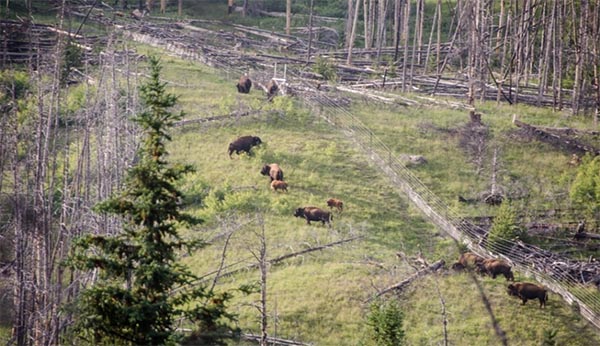
Photo: K. Heuer / Parks Canada
The Plains Bison Reintroduction Pilot
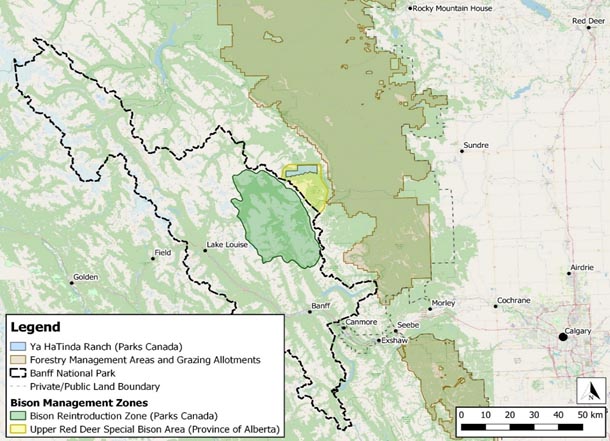
The plains bison reintroduction pilot was built upon public, stakeholder, and Indigenous feedback which resulted in phasing the reintroduction as a five-year pilot, so that bison health, use of habitat, and movements were closely monitored and contained within the park.
The goals and objectives of the reintroduction pilot are in support of Parks Canada’s primary mandate, which is to maintain and restore ecological integrity Footnote 1, enriching visitor experience, facilitating cultural connections, assessing the feasibility of restoring a globally imperiled species, and providing learning and stewardship opportunities, both in the park and from afar.
The five-year phased pilot, commenced in 2017 with blessing ceremonies in Banff National Park, facilitated by Indigenous groups. The pilot included two main phases:
- Soft-release (2017-2018): In early 2017, 16 healthy bison from Elk Island National Park were translocated to an enclosed pasture within the reintroduction zone located in Banff National Park’s eastern slopes. The bison spent two calving seasons in the soft-release pasture – allowing them to bond to their new home. The bison were closely monitored by Parks Canada team members.
- Free-roaming (2018-2022): In the summer of 2018, the bison were released to explore the full reintroduction zone. Mountain ridges and short stretches of wildlife-friendly fencing discouraged bison from leaving the 1,200 km2 reintroduction zone while allowing other wildlife to pass freely. Parks Canada team members monitored the herd and its relationship with the landscape.
Evaluation of the pilot
Following the commitments made in the Reintroduction Plan, with the five-year pilot concluding in 2022, Parks Canada has evaluated results of the pilot based on the eight evaluation factors outlined in the Plan:
- visitor safety & visitor experience impacts
- Indigenous groups & stakeholders - impacts & perspectives (formerly neighbours & partners)
- response to citizen engagement & stewardship programs
- bison home ranges, monitoring & responses
- mitigating effects of the bison project on other species
- bison population growth & population targets
- public awareness, education & appreciation
- factors influencing bison movement & habitat selection
Overall, results demonstrate that the goals and objectives of the pilot were achieved:
- the bison remained healthy and demonstrated a healthy growth rate with minimal mortalities (Table 1), adapted quickly to the mountain habitat, and remained, for the most part, within the Park
- negative impacts to other species were not observed, and there were no threats to human safety or property damage reported
- establishing and strengthening relationships occurred through the involvement of several Indigenous groups and stakeholders throughout the pilot
- a variety of in-park and outreach and educational programs provided the opportunity to enrich visitor experience and understanding
| Year | Animals | Growth rate | Mortality | Excursions |
|---|---|---|---|---|
| Start (Feb 2017) | 16 | |||
| 2017 | 26 | 62.5% | ||
| 2018 | 36 | 38.5% | 2 males | |
| 2019 | 39 | 8.3% | 1 calf | 1 male |
| 2020 | 56 | 43.5% | 1 calf | |
| 2021 | 65 | 21.4% | 1 male |
| Interpretive programs (in-park) | # of Programs | Reach |
|---|---|---|
| 2017 Bison Winter Program (Roving) | 3 | 6,854 |
| 2017 Bison on the Horizon (Theatre) | 48 | |
| 2017 Bison Guardians (Point Talk) | 29 | |
| 2018 Bison Winter Program (Roving) | 11 | 4,662 |
| 2018 Bison – Home on the Range (Theatre) | 22 | |
| 2018 Bison’s New Horizons (Program) | 34 | |
| 2019 Deep in the Backcountry: Bison Stewards (Theatre) | 29 | 2,224 |
| 2019 Banff Bison: Behind the Scenes (Program) | 10 | |
| 2021 Speaker Series: Bison Project Staff (Theatre) | 1 | 55 |
| TOTAL | 187 | 13,981 |
| *Reach: The number of people who saw or engaged with the content/products | ||
Visitor safety and experience impacts
The Banff bison were reintroduced in a remote backcountry area of the park that sees little human use. The reintroduction story was therefore communicated through several interpretive programs (Table 2), reaching nearly 14,000 people over the span of the five-year pilot.
While there were a few backcountry visitors who saw the bison during their wilderness experience, the existence of bison in the backcountry, did not appear to increase visitation to this part of the backcountry. Remote trail cameras (N=6) indicate annual human use remained low, with fewer than 60 human events per year recorded in the heart of the reintroduction zone during the pilot period. Footnote 2 This is well below (~95%) the target threshold of 100 events per month to maintain grizzly bear habitat security, as prescribed in BNP’s Management Plan. Footnote 3
Parks Canada did not receive any visitor or stakeholder complaints about bison inside the Park. Bison generally fled from occasional hiking groups and neither fled nor approached groups on horseback. Outside the park, a lone bull did venture into horse camps, which caused concerns among campers. It was euthanized per the Bison Excursion Response Plan as it continued to wander east.
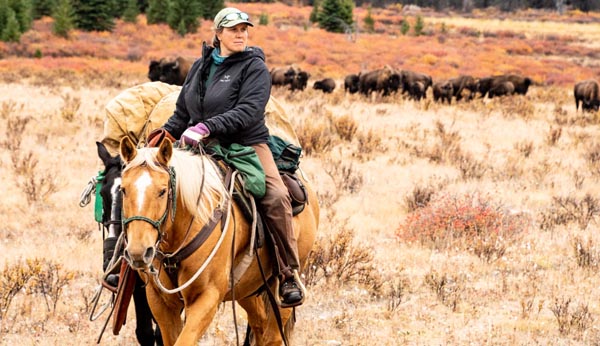
Photo: K. Heuer / Parks Canada
Indigenous groups and stakeholders
Indigenous groups and stakeholders were engaged prior to and during the five-year pilot via biannual project updates, annual progress reports, and formal and informal meetings and phone calls. Many of the initial concerns expressed by stakeholders have been addressed through conversation, adaptive management, and because of the pilot, many stakeholders have expressed reduced concern.
Indigenous groups
Treaty 6 and Treaty 7 Nations, Ktunaxa and Shuswap Bands, as well as the Métis Nation of Alberta were engaged prior to bison reintroduction in BNP and their feedback was considered in revising the project plan. Many First Nations and Métis iterated the need for ceremonies to bless and prepare the animals prior to and during reintroduction. Such ceremonies, designed by Indigenous groups and facilitated with assistance from Parks Canada, occurred before the reintroduction in BNP, during the translocation at Elk Island National Park, and prior to releasing the animals into the backcountry of BNP.
The pilot project also provided opportunities to continue strengthening relationships with several Indigenous groups, and resulted in a traditional knowledge study Footnote 4, an Indigenous youth filmmaking workshop, and annual Indigenous women's and youth hikes into the reintroduction zone. An Indigenous report entitled Enhancing the Reintroduction of Plains Bison in Banff National Park Through Cultural Monitoring and Traditional Knowledge is publicly available through the Canadian Mountain Network website.
Indigenous groups will continue to be engaged with bison restoration in BNP. The pilot highlighted the enduring cultural, historical, and spiritual importance of bison to Indigenous groups and the importance of continuing to foster this special relationship.
Other government organizations and adjacent land managers
The pilot provided opportunities to continue to strengthen relationships with other government organizations and adjacent land managers. For example, the Government of Alberta Ministries of Alberta Environment and Parks and Alberta Agriculture and Forestry engaged on the pilot project by reviewing draft plans and providing permits to recapture bison that left the Park.
Further, through ongoing engagement and collaboration, the Government of Alberta established the 240 km2 Upper Red Deer Special Bison Zone in 2018, to protect wayward bison until Parks Canada team members could respond and recapture or haze them back into the park (Figure 2) Footnote 5. The Government of Alberta will continue to be engaged including, as a first step, sharing this report for their early review and input.
In 2022, the Government of Alberta, Ministry of Alberta Environment and Parks permitted the construction of four secondary bison containment fences in key pinch points to the east of the Upper Red Deer Special Bison Zone.
Cattle ranchers
Livestock grazing allotments begin ~20km beyond the current bison reintroduction zone, and extend to the public/private land boundary 50km east of the park (Figure 2). The livestock industry was concerned at the outset of the project that bison could carry and transmit diseases of concern (e.g., anthrax, brucellosis, and bovine tuberculosis) to cattle if they frequented this area.
An extensive disease risk assessment conducted prior to the reintroduction concluded there was a low probability of this occurring. Footnote 6 Nonetheless, in recognition that the economic consequences to the livestock industry would be significant if it did occur, an in-depth Bison Health Monitoring and Disease Response Plan Footnote 7 was subsequently developed and all preventative measures were followed over the last five years, including:
- sourcing animals from a certified disease-free herd (Elk Island National Park, as per Canadian Food Inspection Agency (CFIA) testing since the 1970s)
- Testing and quarantining the animals prior to translocation, and again prior to releasing them into the wild Footnote 8
- Testing eight animals captured for radio collaring for brucellosis and other diseases after the 2018 release (all were negative) Footnote 9
- Evaluating any dead bison for signs of tuberculosis and other diseases (two that had to be destroyed when they dispersed well beyond the reintroduction zone were necropsied by a licensed veterinarian and found to be in excellent health with no signs of tuberculosis or other diseases)
Other indicators of bison health were closely monitored with reassuring results: body condition for all founder animals averaged in the “good” to “very good” range through the pilot project (Figure 4) Footnote 10, fecal parasite counts were low Footnote 11, calving rates were very high (average 33% herd growth rate per year), and, despite intensive monitoring and frequent field and remote camera observations (radio collars maintained on at least 10% of the herd), no sick animals were detected and only two natural bison mortalities were recorded in the five-year pilot (due to wolf predation of newborns in spring 2020 and 2021).
Although bison excursions (i.e., instances where bison venture beyond the reintroduction zone or the park boundary) were rare during the pilot project, lone bulls did disperse east of the reintroduction zone and the Park on four occasions (see Section 4). Three of these ventured onto livestock grazing allotments in the summers of 2018 and 2019 but did not mingle with cattle or damage any fences. Allotment holders were contacted immediately and PCA successfully recaptured or removed the bison within days, as per the BNP Bison Excursion Response Plan Footnote 111.

Guides and outfitters
Two trail riding outfitters have permits to commercially offer horseback trips into the bison reintroduction zone. Both had early concerns about how their horses would react to bison encounters. The outfitter operating in the Red Deer Valley encountered bison several times during the five-year pilot project and reported positive experiences for clients. The outfitter operating in the Cascade Valley has not yet encountered bison because the animals have not yet explored that valley.
Hunting outfitters also operate just outside the park and reintroduction zone, and rely, in part, on other wildlife freely moving across the park boundary in the fall. They were concerned whether reintroduced bison, and associated drift fencing, would negatively impact such movements, particularly for elk and bighorn sheep. Despite investigating these concerns thoroughly (see Section 2.2.5) there was no evidence found for these concerns at low bison densities.
Recreationists
Dozens of backcountry groups (e.g., backpackers or horse-mounted trail riders) ventured into the bison reintroduction zone during the five-year project1. No reports of aggressive or other negative interactions with the animals were received from these groups during the five-year pilot project.
Most recreationists immediately outside the reintroduction zone and park are also horse riders staging out of the Ya Ha Tinda area (Figure 3). Similar to the trail riding outfitters, their concerns were for prospective aggressive bison-horse encounters. The low number of bison excursions from the reintroduction zone resulted in very few bison-horse encounters, and all but one of the four that did occur were docile and gave people the ability to see wild bison.
The exception was one juvenile bison bull that dispersed east of the reintroduction zone in 2021 and curiously approached several horses in camps, making the owners nervous. The bull subsequently continued without causing harm but was later destroyed by Parks Canada staff in accordance with the Bison Excursion Plan Footnote 12, due to his continued eastward movements outside of the park.
Response to citizen engagement and stewardship programs
Parks Canada exceeded its goal of increasing volunteer opportunities by 1,000 hours through seven backcountry volunteer programs that resulted in over 2,000 volunteer hours during fence construction of the soft release pasture (Figure 5), consulting on the overall project (2016), fortifying drift fencing on the periphery of the reintroduction zone (2018), helping to feed and care for the bison while they were held in the soft release pasture (2017 and 2018), assisting with public outreach (2018-2020), and analyzing data and writing reports (2021).
Bison home ranges, monitoring and responses
The support of some stakeholders for the five-year pilot reintroduction project was contingent on a commitment from Parks Canada to contain bison within the reintroduction zone of BNP (Figure 2).
Strategies to encourage bison to anchor to this target area included starting with a small number of young (2-3-year-old) animals, holding them in a backcountry pasture for 18 months, radio collaring and monitoring at least 10% of the population, hazing them back into the reintroduction zone when required, and complementing the cliffs and steep ridges that surround much of the reintroduction zone with short drift fences constructed in key valleys (Figure 6).
By almost all measures, these strategies worked: the majority of bison (which, as of Fall 2022 is ~ 80 animals) have remained in the reintroduction zone and within 30 km of where they were released (Figure 6). Only four males dispersed outside of the zone and had to either be recaptured and relocated elsewhere (N=2) or were destroyed (N=2), as per the BNP Bison Excursion Response Plan. Footnote 11
Home range and movements
The rate of bison exploration has diminished with time since release. The main bison population explored 257 km2 of the 1200 km2 reintroduction zone during the pilot period, the majority of which occurred over the first year (81.7%) Footnote 13. Explorations occurred more in summer (45.5%) and fall (32.3%) than in winter (7.3%) or spring (14.8%) Footnote 13.
The decline in exploration after the first year did not translate to less movement: daily movement remained steady between years (median of 1.9km/day) Footnote 12 but large and rapid movements (e.g., ≥ 4.0 km in 2 hours) dropped by 51% after the first year, suggesting the animals did settle over time. Footnote 133 This was further supported by a contraction in the size of their annual home range between the first and second years (133.2 km2 to 92.9 km2). Footnote 14
The movements of the reintroduced bison have been highly asymmetrical (Figure 6): 97% of GPS collar positions occurred to the northwest, north, and northeast of the release site Footnote 13, and all explorations of the edge of the reintroduction zone occurred in these directions. Movements in all remaining directions account for only 3% of locations.
A number of hypotheses could explain these movements: many river valleys drain north or east in the study area, the more open and grassier (southwest-facing slopes) of the reintroduction zone are always in a northeast direction, and the national park from which the animals were sourced (Elk Island) is in a northeast direction. Notwithstanding their asymmetrical pattern of exploration, the reintroduced Banff bison have developed a home range with predictable travel paths between preferred areas in the reintroduction zone, suggesting a learned fidelity for the area.

Photo: K. Heuer / Parks Canada
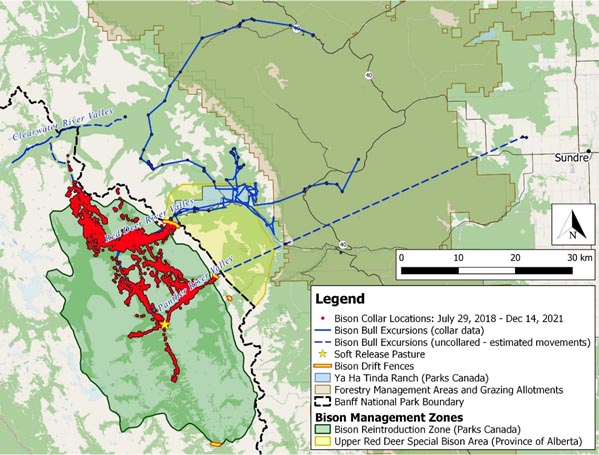
Responses to management interventions
It is important to note, however, that this fidelity and bison movements have been heavily influenced by management interventions, most notably two drift fences in the Panther and Red Deer valleys (Figure 7). These two drift fences have prevented north easterly bison movements outside of the reintroduction zone on 50 occasions since they were released, and the frequency of these visits has not diminished with time (Figure 7). Hazing the animals back into the reintroduction zone using low-stress herding techniques has also been necessary, albeit on fewer occasions (N=7) Footnote 15. These forays have also been in a northward direction (towards the Clearwater Valley from Divide Creek).
Mitigating effects of the bison project on other species
Competition between bison and species that are hunted outside the park (e.g., bighorn sheep and elk), and the potential impacts of bison drift fences on broader wildlife movement was a concern of Indigenous groups and stakeholders. Mitigations were put in place to address these concerns in two ways: 1) by testing for and adopting a proven wildlife-friendly design before deploying drift fences to help contain bison; and 2) by searching for early evidence of bison directly impacting other species.
Wildlife-friendly drift fences
To encourage bison to anchor to the reintroduction zone, Parks Canada built 13 adjustable drift fences designed to encourage bison from leaving the reintroduction zone. Collectively they spanned 7.8 km across 13 pinch points on the periphery of the reintroduction zone in 2017 and 2018. Of these, two (Panther and Red Deer) have proven to be crucial to encouraging bison to stay in the reintroduction zone. Some of the others were ineffective or unnecessary and nine were removed over the last several years. Only six kilometers of drift fencing remains across four sites (Figure 6).
To arrive at the optimal design of these fences, Parks Canada team members rigorously tested several configurations and analyzed 6,104 wildlife-fence interactions with 34 remote cameras. The resulting design was a 150cm-high, five-wire fence that is permeable to wildlife but deflects bison (Figure 8) Footnote 16. There were no significant changes in wildlife activity, speed or through movements before versus after fence construction.
Monitoring and maintenance of these fences is ongoing. Located in remote, rugged terrain, they are prone to damage from fallen trees and seasonal flooding, requiring frequent maintenance checks.
Impacts of bison on other species
Parks Canada searched for evidence of bison directly impacting other wildlife. Long-term elk GPS radio collar data from the Ya Ha Tinda elk project Footnote 17 was analyzed along with bison GPS radio collar data to assess whether there might be competitive (negative) or facultative (beneficial) interactions between the two species.
Fewer than 50 elk currently use the bison reintroduction zone, making competition (which requires a resource to be limited), unlikely, especially at low bison densities. Elk and bison overlapped minimally in spring and summer (Figure 9), and neither the distribution of elk, nor how elk used and selected habitat changed after bison reintroduction. Footnote 18
A focused bighorn sheep study also began soon after bison were reintroduced. Footnote 19 Fifteen bighorn sheep were radio collared throughout the bison reintroduction zone and another 25 collared elsewhere in BNP (196,103 locations). Bison and sheep were observed in close proximity in parts of the reintroduction zone, however home range maps showed low levels of spatial overlap between species.
Further analysis of habitat use revealed broad-scale resource separation, with sheep selecting higher elevations and steeper slopes than bison in all seasons (Figure 10). Using newly created sheep habitat models, the proportion of bison locations in higher quality sheep habitats was shown to fluctuate by season; the greatest proportions were seen in winter and spring as both species selected strongly for grassland habitat types.
Bighorn sheep are relatively numerous in the area, with 364 individuals counted in the bison reintroduction zone during an aerial survey in 2020 Footnote 20. Though spatial overlap is low, and the species are broadly separated by habitat selection, seasonal use of higher quality sheep habitat by bison could lead to range competition in some areas if bison numbers increase significantly. Efforts to track wolf response to the initial reintroduction of bison were hampered by high wolf mortality due to trapping outside the park. Footnote 21 However, two wolves were GPS-collared and survived for a few months before being trapped outside the park in the first winter (2018/19) after bison were released. The wolves approached the reintroduced animals repeatedly, but their advances did not elicit corresponding movements from GPS-collared bison. Photos from Parks Canada’s remote camera network show a similar lack of response from reintroduced bison to the presence of wolves. In a couple of instances, curious juvenile bison males chased wolves.
Bison reintroduced elsewhere have positively impacted other wildlife (and soils and vegetation) Footnote 22. Such ecosystem effects and the restoration of ecological integrity are important goals for this project. Long term studies to quantify some of these effects (e.g., influence of bison grazing on breeding bird distribution and the structure of vegetation) are underway in BNP.
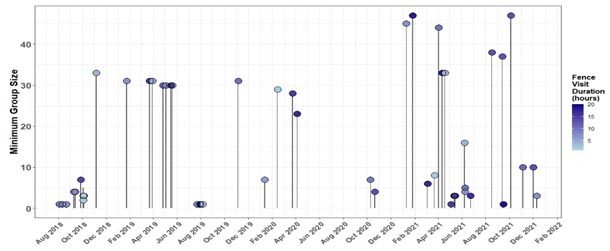
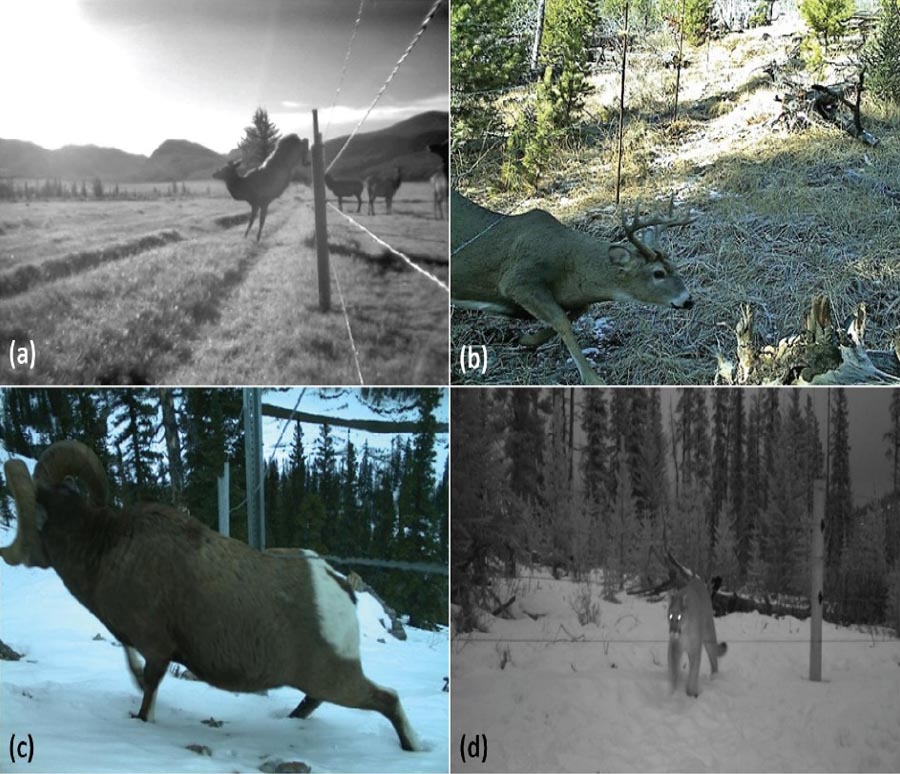

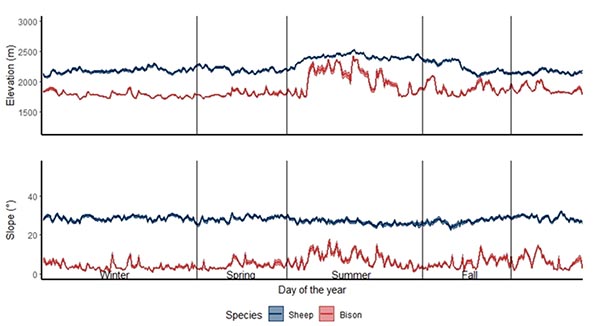
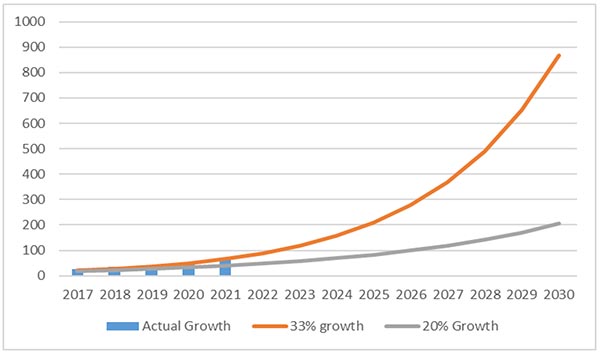
Figure 11 — Text version
| Year | Actual growth | Population growth at 20% per year | Population growth at 33% per year |
|---|---|---|---|
| 2017 | 26 | 19 | 21 |
| 2018 | 34 | 23 | 28 |
| 2019 | 36 | 28 | 38 |
| 2020 | 50 | 33 | 50 |
| 2021 | 65 | 40 | 67 |
| 2022 | 48 | 89 | |
| 2023 | 57 | 118 | |
| 2024 | 69 | 157 | |
| 2025 | 83 | 208 | |
| 2026 | 99 | 277 | |
| 2027 | 119 | 369 | |
| 2028 | 143 | 490 | |
| 2029 | 171 | 652 | |
| 2030 | 205 | 867 | |
| 2031 | 247 | 1153 | |
| 2032 | 296 | 1534 | |
| 2033 | 355 | 2040 | |
| 2034 | 426 | 2713 | |
| 2035 | 511 | 3608 | |
| 2036 | 613 | 4799 | |
| 2037 | 736 | 6383 | |
| 2038 | 883 | 8489 | |
| 2039 | 1060 | 11290 | |
| 2040 | 1272 | 15016 | |
| 2041 | 1526 | 19972 | |
| 2042 | 1832 | 26562 | |
| 2043 | 2198 | 35328 | |
| 2044 | 2638 | 46986 | |
| 2045 | 3165 | 62491 | |
| 2046 | 3798 | 83113 | |
| 2047 | 4558 | 110540 | |
| 2048 | 5469 | 147019 | |
| 2049 | 6563 | 195535 | |
| 2050 | 7876 | 260061 |
Bison population growth and population targets
Bison population growth during the pilot project averaged 33% per year and natural mortality was less than 1% per year. The removal of four dispersing males over the five-year pilot was also approximately 1% per year. As a result, the 16 translocated animals grew into a population of ~80 animals over the duration of the pilot.
Growth rates are expected to moderate somewhat as the predominantly young and female founding animals age and the sex ratio balances, but even the average growth rate for wild herds in North America (20%/yr.) would result in more than 200 animals within eight years (Figure 11). This kind of growth is encouraging for species recovery where hundreds or thousands of animals are needed to insulate against genetic drift, extreme weather, and other forces of extinction. Footnote 23 However, the population (and range) of every modern free-roaming plains bison herd in North America is limited by surrounding development and is ultimately managed by people, either through Indigenous and non-Indigenous harvest (e.g. Pink Mountain, B.C.; Henry Mountains, Utah), frequent roundups, relocations, auctions and removals (e.g. Grasslands and Elk Island national parks), or both (e.g. Yellowstone National Park).
The BNP situation is no different: although opportunities to expand bison range may exist within and outside the park, they will ultimately be limited by outlying agriculture, other human developments, and active management.
Public awareness, education and appreciation
The story of the bison reintroduction reached almost 120 million people (Table 3), in an effort aimed at expanding public appreciation for Parks Canada’s role in conservation. This was achieved by transmitting the story from the backcountry as it unfolded, in ways that delivered it to peoples’ doorsteps and devices.
This included 13 webisodes (e.g., Free and Thriving Footnote 24), digital storytelling (Bison Blog and associated social media posts), and many articles, and television and radio interviews in traditional media, all of which were received enthusiastically by the public. Collectively, an estimated 119.5 million people were reached with the Banff Bison story since the project began in 2017. This indicates a strong public awareness and appreciation of the bison pilot project amongst Canadians.
Factors influencing bison movement and habitat selection
A bison habitat assessment for the area was completed before the pilot began. Now, after having bison on the landscape for more than three years, we can compare predictions with actual habitat use. Assessment reasonably predicted winter bison use of low-elevation meadows and the bison’s preference for forests burned in the last 15 years. However, it poorly predicted their habitat use in summer. The animals spent more time at higher elevations, on steeper slopes (Figure 12), in shrubs, and further from water than expected. These trends were surprising and demonstrated a remarkable adaptability for animals that were translocated from a non-mountainous environment.
The bison have consistently returned to high elevations during each peak growing season, which could be explained by an analysis of bison scat that found forage at high elevations to be nutritionally superior and more palatable to forage found at lower elevations in the summer. This is precisely what past research has shown for elk in the area Footnote 25. Exploiting this difference is critical in June, July, and August when plant nutrients peak and bison can recover from a declining winter body condition, and gain nourishment for lactation. Low inter-year differences in dietary efficiency shows just how adaptable the bison are: despite coming from a non-mountainous environment, they honed in on the altitudinal distribution of summertime nutrients almost immediately.
An updated Resource Selection Function for bison in the reintroduction zone now replaces the old habitat model. Footnote 12 Built from bison GPS collar data collected since the animals were released, it forms the basis for a new predictive bison movement model that projects where the animals would have gone if they had unimpeded access to areas beyond the target reintroduction zone (Figure 13). It accurately predicts their preferred areas of the reintroduction zone (e.g., middle Panther and lower Red Deer valleys) but also shows them strongly attracted to the nearby Ya Ha Tinda and Panther Corners areas outside the park (and to a lesser extent the Bow Valley in BNP). The model predicts that, without management interventions, individual bison would have exited the reintroduction zone and made their way to these areas within eight or nine months of release, significantly decreasing the time they explored (and presumably bonded to) the target reintroduction area.
| Initiatives | Product(s) | Number of completed products/events between 2017-2021 | Estimated reach |
|---|---|---|---|
| Digital storytelling | Video assets | (5) Webisodes (7) Short videos |
Over 270,000 thousand video views |
| Website content | (33) blog posts (5) web pages total |
Over 111,500 thousand unique page visitors | |
| Social media | (57+) social media posts | Over 1.7 million impressions | |
| Email newsletters | (1) Parks Canada E-Blast | Over 2.3 million email contacts distributed to | |
| Traditional media | Media stories and interest | (3) Press conferences (135+) Media requests |
Over 111 million potential audience |
| Documentary film projects | (12) Documentary projects/films | Over 8.9 million potential audience | |
| Outreach and education | Outreach events and partnerships | (40+) Events attended (4) Partnerships (6) Hosted events |
Over 505,000 thousand direct and/or non-personal contacts |
| Mountain World Heritage Interpretive Theater | (10) Online Programs delivered (3) In-park Programs developed |
Over 11,184 thousand direct contacts | |
| Non-personal media products | (1) Xplorer’s Book (1) Backcountry Brochure (1) Trail head signage |
Over 475,000 thousand products distributed | |
| TOTAL REACH OF BISON COMMUNICATIONS DURING THE PILOT: 125.2 MILLION | |||
| *Reach: The number of people who saw or engaged with the content/products | |||

Photo: K. Heuer / Parks Canada
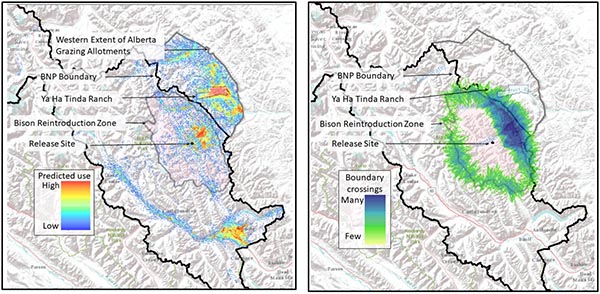
Conclusion and next steps
Summary
The five-year pilot represents the most recent efforts of Parks Canada in supporting the recovery of plains bison and has identified that Banff National Park is a feasible location where bison can successfully exist on the landscape.
The 16 animals translocated from Elk Island National Park in 2017 adapted quickly to Banff’s mountain environment and remained healthy growing to ~80 animals during the five-year project. The robust growth rate suggests the population could reach a point in the next 10 years where extinction from random catastrophic events (e.g., disease outbreaks or extreme weather events) or genetic drift is improbable. This is a significant accomplishment given plains bison occur in only five other isolated wild subpopulations, currently occupy less than 0.5% of their original range in North America, and are rarely subject to natural selection. Banff National Park, with its full suite of native large carnivores, represents a unique and rare opportunity where this can still happen. Footnote 26
The five-year bison reintroduction pilot sets a strong foundation of knowledge and practice to support long-term feasibility. Many of the initial concerns expressed by stakeholders have been addressed. These positive findings and trends support a future where bison remain on the landscape within a controlled and measured form.
Next steps
Following the direction of the 2015 Plains Bison Reintroduction Plan, and in support of the long-term feasibility of the bison program in Banff National Park, this report was shared for Indigenous, stakeholder, and public review. Feedback has been used to help finalize this report and has been considered by Parks Canada in determining next steps. Please refer to the publicly available What We Heard for more information on results of engagement.
Overall, Parks Canada heard that the five-year reintroduction pilot was a success and there is strong support for a future with bison on the landscape. Based on results of the pilot and what we heard, bison will remain on the landscape within Banff National Park for the foreseeable future. What that looks like and how bison will be managed moving forward will be explored by Parks Canada through the development of a Bison Management Plan. This plan will include longer term monitoring and adaptive management, including range and population targets, and will be produced through ongoing collaborations with the Province of Alberta, Indigenous groups, and other key stakeholders.
Related links
- Date modified :